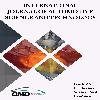Investigation of The Effect of Solid Lubricant Particle Sizes on Friction and Wear Properties in Friction Composites: An Experimental Case Study with Graphite
Friction composites consist of many materials with various properties. Solid lubricant is one of these materials. The task of the solid lubricant in the compo-site is to protect the counter surfaces against wear and to reduce noise and vibra-tion. Typical solid lubricants used in the friction composite are graphite, antimo-ny trisulfide, molybdenum disulfide, copper sulfide, etc. The selection suitable solid lubricants for better braking performance is an important issue, as solid lubricants may decompose at high temperatures, leading to undesirable results. The particle size of the solid lubricant used is at least as important as itself. In this study, the effect of micro and nanoparticle-sized graphite on friction and wear behavior of friction composites was investigated experimentally. Two brake lining were prepared containing 10 wt.% nanographite and micrographite, were produced by powder metallurgy technique. The brake lining samples have been tested under Friction Assessment and Screening Test (FAST). The frictional and physical properties of the produced samples were determined by appropriate tests. According to the test results obtained, micro and nanoparticle size were compared in many respects and the most ideal size was determined for graphite.
Keywords:
Graphite, Brake lining, Friction Wear, Tribology,
___
- [1] Sugözü B. Tribological properties of automotive brake pads containing peanut shell powder. Int J Res Eng. 2019;1: 20-24.
- [2] Cho KH, Jang H, Hong YS, Kim SJ, Basch RH, Fash JW. The size effect of zircon particles on the friction characteristics of brake lining materials. App Surf Sci. 2008; 258:1862-1868.
- [3] Kumar M, Ahlawat V, Sharma V, Kumar M, Singh M. Effect of sliding velocity on wear behaviour and coefficient of friction of walnut shell powder/polyester composites. J Compos Theory. 2019; 12: 730-739.
- [4] Venkatesh S, Murugapoopathiraja K. Scoping review of brake friction material for automotive. Mater Today. 2019;16: 927-933
- [5] Jadhav SP, Sawant SH. A review paper: Development of novel friction material for vehicle brake pad application to minimize environmental and health issues. Mater Today. 2019; 19:209-212.
- [6] Abdel-Rahima1 YM, Darwish SM. Generalized braking charac-teristics of friction pad synthetic graphite composites. Tribol Int. 2010; 43(4): 838-843.
- [7] Cho MH, Ju J, Kim SJ, Jang H. Tribological properties of solid lubricants (graphite, Sb2S3, MoS2) for automotive brake friction materials. Wear. 2006; 260: 855-860.
- [8] Kim SJ, Cho MH, Cho KH, Jang H. Complementary effects of solid lubricants in the automotive brake lining. Wear. 2007; 40:15-20.
- [9] Sugözü I. Investigation of using rice husk dust and ulexite in automotive brake pads. Mater Test. 2015;57(10): 877-882.
- [10] TSE 555. Highway Vehicles-Brake System-Brake Pads for Friction Brake. Turkish Standard Institute. Ankara, Turkey. 1992.
- [11] Bijwe J, Aranganathan N, Sharma S, Dureja N, Kumar, R. Nano-abrasives in friction materials-influence on tribological properties. Wear. 2012;296:693-701.
- [12] Persson BNJ. Theory of Friction - the Role of Elasticity in Boundary Lubrication. Phys Rev B, 1994;50 (7):4771-4786.
- [13] Tabor D. Friction as a dissipated process, Friction of organic polymers in fundamentals of friction. Macroscopic and Microscopik Processes, 1996;3:220.
- [14] Sugozu B. Tribological properties of brake friction mate-rials containing fly ash. Ind Lubr Tribol. 2018;70: 902-906.
- [15] Ostermeyer GP. On the dynamics of the friction coeffi-cient. Wear. 2003;254: 852-858.
- [16] Anderson AE. Friction and Wear of Automotive Brakes, USA, Friction, Lubrication and Wear Technology ASM Hand-book. 1992.
- [17] Stachowiak GW, Batchelor AW. Adhesion and adhesive wear, In: Engineering Tribology, Eds, A.B.D: Butterworth-Heinemann, 2001;533-553.
- [18] Moore DF, Princippless and application tribology, Ox-ford, Pergamon Press. 1975;109-156.
- [19] Jeganmohan S, Sugozu B. Usage of powder pinus brutia cone and colemanite combination in brake friction composites as friction modifier. Mater Today-Proc. 2020; 27:2072-2075.
- Yayın Aralığı: Yılda 4 Sayı
- Başlangıç: 2016
- Yayıncı: Otomotiv Mühendisleri Derneği
Sayıdaki Diğer Makaleler
Şükran KATMER, Ulvi ŞEKER, Gökhan KÜÇÜKTÜRK, Hakan KÜÇÜKTÜRK, Çağlar YAVAŞ
Müjdat ERSARI, Selahattin SARI, Ali İlker TÜĞRU, Hüseyin ERKEK
Yunus Emre EKİCİ, Teoman KARADAĞ, Mustafa NURMUHAMMED, İsmail Can DİKMEN
Kemal ERMİŞ, Muhammed Talha AŞKA
Finance Methods in the Automotive Sector -Business Agility in the Age of Digital Disruption
